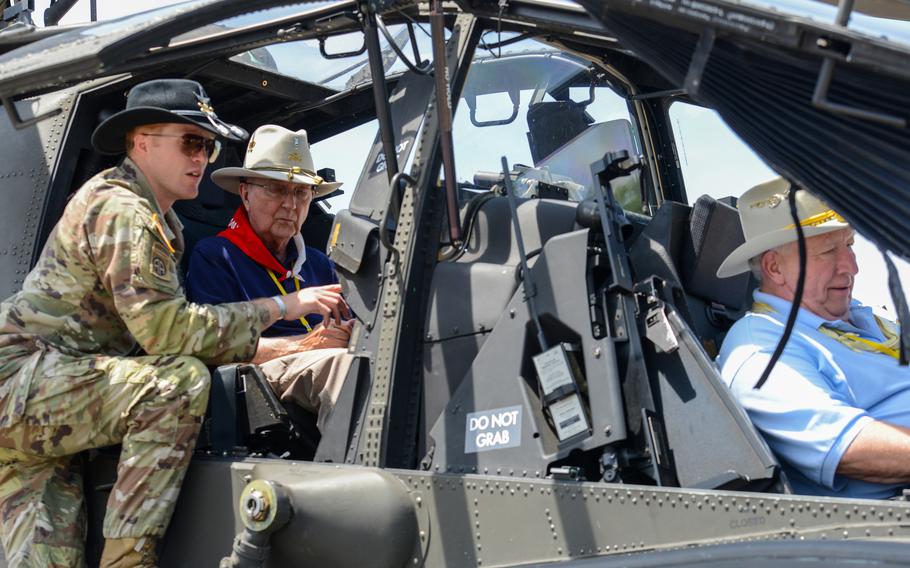
Army Warrant Officer 1 Bobby Keen, an AH-64 Apache pilot, shows Vietnam veterans the inside of the helicopter on April 25, 2025, during a reunion of 3rd Squadron, 17th Cavalry Regiment troopers who served as pilots in Vietnam. The Vietnam veterans spent time with current members of their old unit, including Keen, which is now stationed at Hunter Army Airfield in Savannah, Ga. (Corey Dickstein/Stars and Stripes)
SAVANNAH, Ga. — One by one, men in their 70s and 80s climbed up and entered the AH-64E Apache attack helicopter at Hunter Army Airfield, eliciting smiles and memories of their time piloting the choppers of their day over the battlefields of South Vietnam.
“It’s the most beautiful thing I’ve ever seen,” said Byron Jones, a former Army captain who led a platoon of OH-6 Cayuse scout helicopters in Vietnam. “I wish they’d let me fly it.”
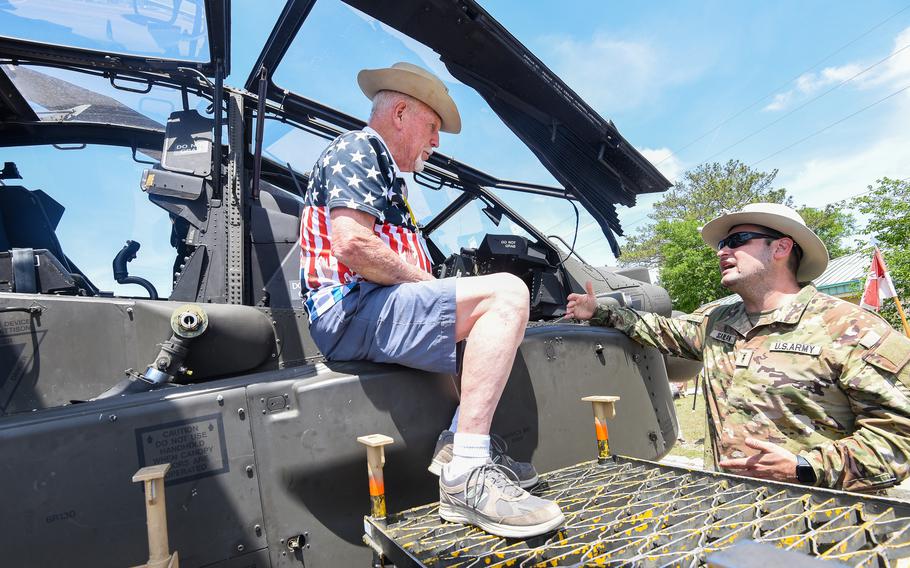
Vietnam War OH-6 scout helicopter pilot Byron Jones climbs into an AH-64 Apache and talks with Chief Warrant Officer 2 Patrick Scanlan on April 25, 2025, at Hunter Army Airfield during a reunion of 3rd Squadron, 17th Cavalry Regiment troopers who served in Vietnam. The Vietnam veterans spent time with current members of their old unit that is now stationed at Hunter in Savannah, Ga. (Corey Dickstein/Stars and Stripes)
At 85 years old, the climb up to the Apache was not easy for Bill Bailey, but the former UH-1 Huey pilot was determined to get a look inside the “amazing, amazing machine,” which today carries on the legacy of the air cavalry mission pilots such as Bailey and Jones forged during the Vietnam War.
The men were among a group of more than 30 Vietnam air cavalry veterans to visit a contemporary air cavalry unit last week at Hunter AAF in Savannah, Ga. That unit — the 3rd Squadron, 17th Cavalry Regiment, known as the Lighthorse squadron — is the modern-day iteration of the unit that Bailey, Jones and the other Vietnam veterans visiting Savannah served with in the 1960s and 1970s.
Most of the Vietnam veterans sported the white-grey Stetson cavalry hats, known as “Silver Bellies,” favored by their units in Vietnam, and which commanders of 3-17’s Charlie Company still wear in an ode to their service. The men swapped old war stories and cracked jokes with each other like 20-something soldiers. They posed for photos with their camouflage-clad contemporaries and the Apaches and listened as the current Lighthorse soldiers explained how the air cavalry mission is conducted in modern times.
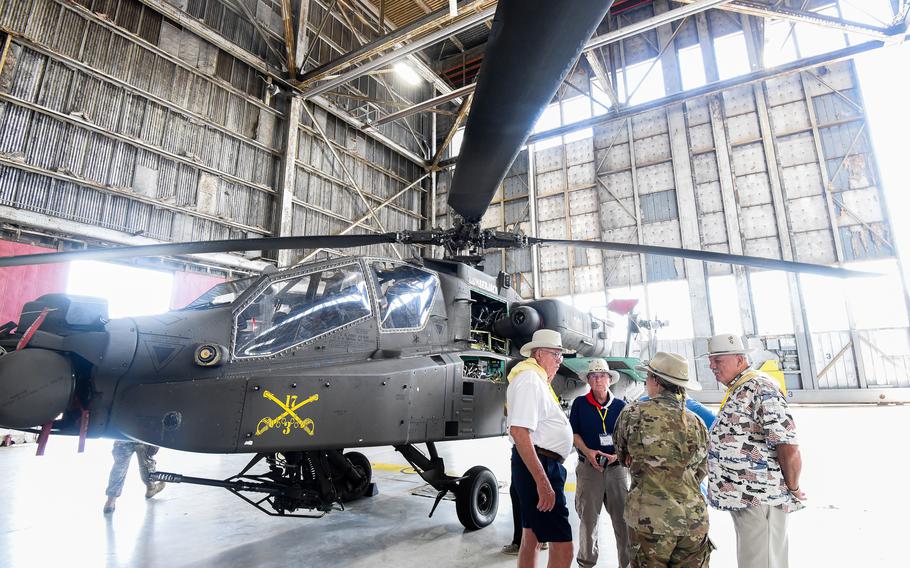
Vietnam War veterans who flew with the 3rd Squadron, 17th Air Cavalry Regiment speak with Army Capt. Genevieve McCormick, the commander of Charlie Company, 3rd Squadron, 17th Cavalry Regiment, next to an AH-64 Apache helicopter in a hangar at Hunter Army Airfield in Savannah, Ga., on April 25, 2025. The Vietnam veterans were visiting their old unit during a reunion for those who served in Vietnam. (Corey Dickstein/Stars and Stripes)
For many of the veterans, it marked a return to Hunter Army Airfield where they learned to fly the Apache’s predecessor, the AH-1 Cobra attack helicopter before shipping off to Vietnam.
The three-day reunion, the 32nd annual get together for the group, served as a chance to reconnect and reminisce about an event decades ago that bonded them for a lifetime, the veterans said.
“It’s necessary,” said Patt Will, who flew Cobras in Vietnam for one year in 1969 and 1970. “For me — I can talk about stuff that I can’t talk about with anyone else, not even with my wife, because I don’t think anybody’s really going to understand.”
Many of the men consider themselves lucky to have survived Vietnam, much less to have lived into their 70s and beyond. Most have near-death stories from flying missions over the Mekong Delta and other parts of southern Vietnam and into Cambodia.
For Will, 75, of Monticello, Ga., the first few months in Vietnam saw him flying Hueys. While he watched other pilots take repeated shots from enemy fire — many suffering multiple shoot downs — he managed to avoid taking any damage. When an opening came to fly Cobras, Will took it.
Piloting his Cobra in December 1969, Will thought his luck had finally run out. A single round cut through his front-seat canopy, missing the armored seats, tore through the helicopter’s command panel and struck his copilot, Warrant Officer 1 Gerald Niewenhous, in the abdomen, leaving him paralyzed from the waist down and in tremendous pain.
“I hear him yelling, ‘I’m hit. I’m hit,’ ” Will recalled, noting Niewenhous could not move his feet from the pedals which sent the Cobra into a spin at some 200 or 300 feet in the air. “I figured I was going to be dead.”
Will managed to wrest control of the chopper and flew it to safety, but Niewenhous died of his injuries.
That event and others in Vietnam left deep marks on Will, he said, and he thinks about his tour there every day. Events such as the reunion last week, he said, have proven therapeutic for him – especially after going some 20 years after leaving the Army without so much as mentioning his service because of the unpopularity in the United States of the Vietnam War.
“The bottom line is, we were all brothers,” Will said. “Our mission in Vietnam was to watch everybody’s ass and make sure those of us who could go home, could go home alive. That was our first mission. All the other missions were something that we trained for, but we learned how to do that and that bonded us for life.”
The Vietnam War saw the first tests of the Army’s air cavalry concept with the 1965 deployment of the experimental 1st Squadron, 9th Air Cavalry. By the war’s end, five squadrons would serve in Vietnam, including the 3-17.
The cavalry squadrons flew AH-1 Cobra attack helicopters, UH-1 Hueys and OH-6 Cayuse light scout helicopters that were better known as Loaches, said Rex Gooch, who flew Hueys in Vietnam with the 3-17 and has authored two books about the unit and its soldier’s experiences there.
The job of the Loach pilots was to fly low to the ground — as close as four or five feet from the surface — to scout out footprints, weapons, ammo boxes or any other evidence of enemy activity in the area, Gooch said. Meanwhile, the Cobra pilots flew overhead waiting for enemy contact. The Hueys were responsible for command and control and lifting troops in and out of battle.
When the Loaches took heavy fire, they would typically peel off and the Cobras, armed with rocket launchers and machine guns, would dive down at the enemies to destroy them.
“This tactic was highly effective against the Viet Cong in the Mekong Delta,” Gooch said.
Bailey of Fredericksburg, Va., was among the first troopers in1967 to arrive in South Vietnam with Delta Troop of the 3rd Squadron, 5th Air Cavalry, which would eventually become the unit known as Lighthorse — Charlie Troop, 3rd Squadron, 17th Air Cavalry.
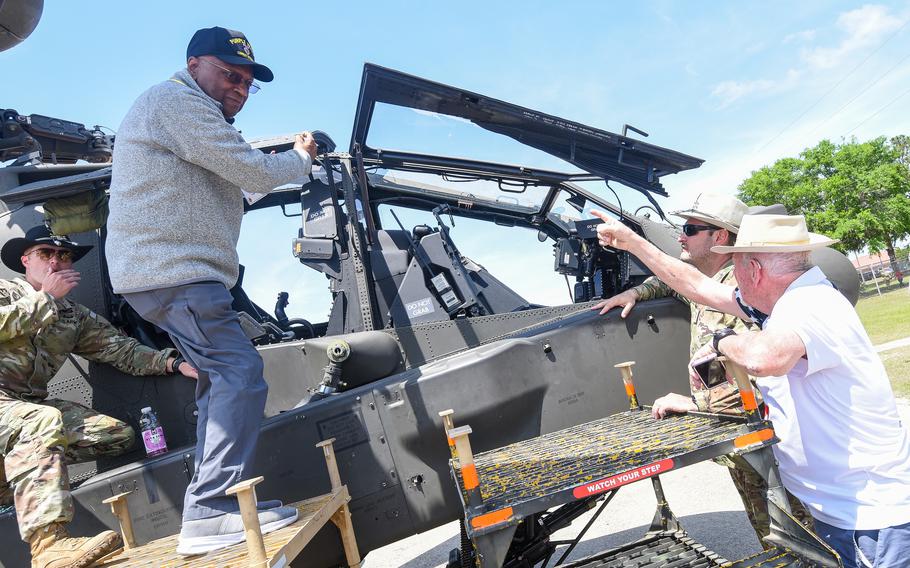
Vietnam War UH-1 pilot Bill Bailey climbs up to look inside an a AH-64 Apache on April 25, 2025, during a reunion of 3rd Squadron, 17th Cavalry Regiment troopers who served in Vietnam. The Vietnam veterans spent time with current members of their old unit that is now stationed at Hunter Army Airfield in Savannah, Ga. (Corey Dickstein/Stars and Stripes)
Like Will, Bailey suffered a close call early in his Vietnam tour. In July 1967, Bailey was piloting a UH-1 alongside his close friend Roger Fraser when they came upon American forces taking heavy casualties in a “serious, serious firefight” with enemy troops.
Bailey and Fraser maneuvered their helicopter to evacuate some of the pinned-down forces. After landing, the aircraft started taking heavy fire and Bailey suddenly felt his arm burning.
“I thought maybe the crew chief had spilled cold water down my back or something,” he recalled. “My shoulder’s burning, my arm’s burning, and I had no idea I had been hit.”
The bullet tore straight through Bailey’s shoulder, forcing Fraser to make the call to evacuate his friend — a decision that Bailey credits with saving his life.
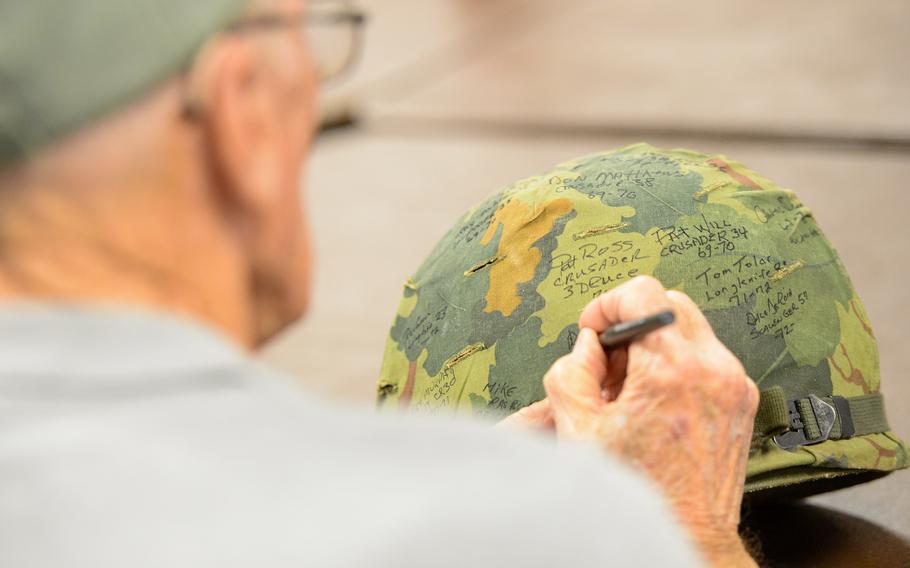
Roger Fraser, who flew UH-1 Huey helicopters in Vietnam, signs a Vietnam-era helmet for Chief Warrant Officer 2 Skyler Vakery, an AH-64 Apache helicopter pilot with the 3rd Squadron, 17th Cavalry Regiment, on April 25, 2025. Fraser was among a group of Vietnam War air cavalry pilots who visited with Vakery’s unit at Hunter Army Airfield in Savannah, Ga. (Corey Dickstein/Stars and Stripes)
“I just flew him to the hospital,” Fraser, 83, said of the incident, which cemented the two men’s tight bond that has remained close since their Vietnam days.
The pair said last week that they were thrilled to meet with the modern air cavalry soldiers who have taken up their legacy.
“It’s been tremendous,” said Bailey, who went on to serve more than 20 years in the Army. “For these youngsters to come and accept us old fellows and to understand that we paved the way for them, to recognize that and take an interest in that – it’s an awesome experience.”
A self-described “history buff,” Army Capt. Larry Glover said he could not pass up the opportunity to spend time with the Vietnam veterans who once manned the unit in which he now serves.
A company commander in the 3-17, Glover said he spent his time with the Vietnam veterans trading war stories and comparing his time flying Apaches in Afghanistan with their experiences flying in Vietnam — especially as one of the few current troopers in the unit with combat experience. Glover had served a deployment to Afghanistan as an enlisted UH-60 Black Hawk crew chief before commissioning and returning to Afghanistan as a pilot in 2019 with the 10th Mountain Division’s 6th Squadron, 6th Cavalry Regiment.
The first months of that tour were busy, which came as U.S. forces increased attacks on Taliban fighters to drive ongoing negotiations toward the withdrawal agreement the two sides ultimately struck in early 2020. The tactics used in those months were shaped largely by the experiences air cavalry officers faced in Vietnam, he said.
“All the doctrine we have, they wrote it,” Glover said. “They wrote the fundamentals, the basics. They lived it.”
The visit last week, he said, gave him a unique chance to “pick their brains” and understand their thought processes as they rooted out North Vietnamese and Vietcong fighters across South Vietnam five decades ago.
“It gives a lot of insight into what we currently do and how we currently train,” Glover said. “There’s a reason for what our doctrine is, and it’s not written in black ink, it’s written in red blood.”
The reunion came at a busy time for the current 3-17 troopers, who are in the middle of conducting aerial gunnery training as part of their preparations for a potential deployment. But the busy schedule did not halt dozens of 3-17 soldiers, pilots and enlisted soldiers, from participating in the reunion.
First Lt. Hayden Moelter, a platoon leader in the squadron’s Charlie troop, said he would “never forget” his time with the group of Vietnam veterans.
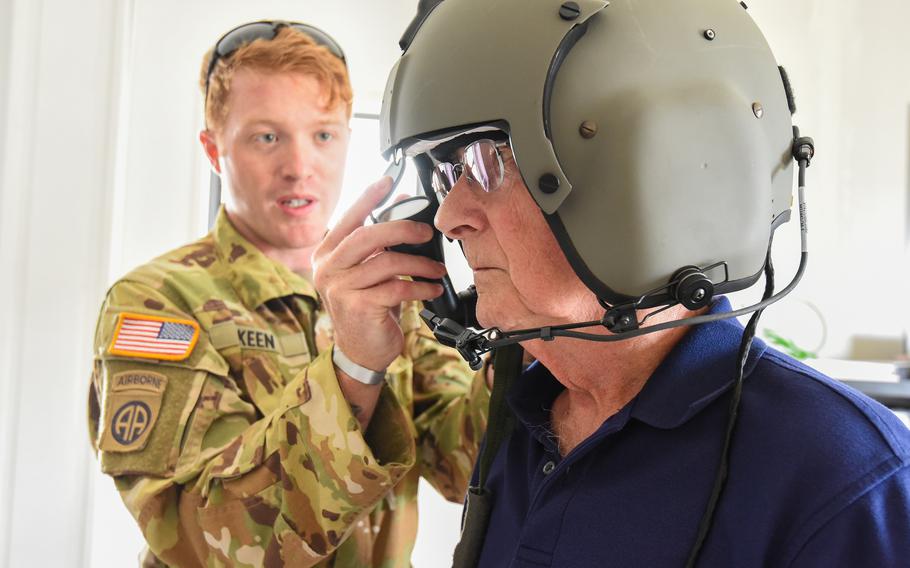
Army Warrant Officer 1 Bobby Keen, an AH-64 Apache pilot, helps Rex Gooch, who flew UH-1 Huey helicopters in the Vietnam War, try on a modern helmet that Apache pilots wear at Hunter Army Airfield in Savannah, Ga., on April 24, 2025. Gooch was visiting the 3rd Squadron, 17th Cavalry Regiment— an Apache flying unit from the 3rd Infantry Division’s 3rd Combat Aviation Brigade — during a reunion of veterans who served in that unit during the Vietnam War. (Corey Dickstein/Stars and Stripes)
Moelter helped the Vietnam group plan the portions of their Savannah visit on Hunter, taking on an extra job even as he had to prepare his platoon for gunnery and for whatever mission comes next.
“Although our operations did not cease, for all of us … the reunion was a perfect reminder to take a moment to reflect on our history and see how the present has developed from the past,” he said.
The experience was humbling, said Chief Warrant Officer 2 Skyler Vakery, who had the veterans sign a Vietnam-era Army helmet that he intends to add to his collection of military memorabilia and eventually build a museum.
“It makes me extremely proud to wear the uniform,” the Apache pilot said. “I tell them, ‘If it wasn’t for you, I wouldn’t be wearing it today.’ ”
For Jim Burch, the visit with the current 3-17 served as a reminder that the Vietnam veteran’s legacy remains alive today. Burch, 76, of Huntsville, Ala., flew Cobra’s in Vietnam from January 1970 to January 1971 and ultimately served 31 years in the Army before retiring as a lieutenant colonel.
“These young guys are carrying the baton,” he said. “I’m so impressed with them. And interestingly, they have the exact same attitude we did: ‘We’re going to get it done, and we’ll do whatever it takes to get the job done.’”
Burch said he was thankful the Army gave him and his comrades the opportunity to meet with the current soldiers as well as a new chance to keep up with those he had served with in Vietnam.
“There’s a camaraderie developed in battle almost all units have forged — these friendships are forged in steel and flames, right? So, we get together even though we live all over the country, when we come back together, we have a lot of fun with each other,” he said. “We all depended on each other. That’s what made us strong. We knew we could depend on that guy. You never had to ask, we just knew it was going to happen and that’s something you can’t fake and you can’t, maybe, build anywhere other than in combat.”